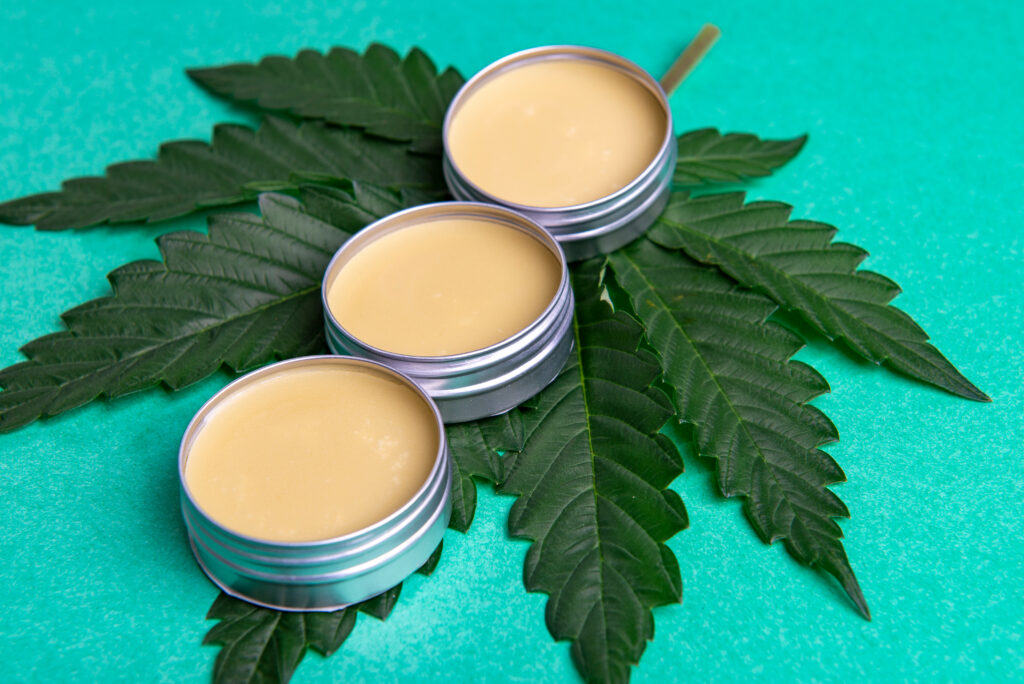
One in five adults in the U.S. live with daily chronic pain, with their backs, hips, knees, and feet being the most commonly affected body parts. Living with chronic pain can severely limit your ability to carry out daily activities, such as working, spending time with loved ones, or even just keeping up with your household chores.
Not to mention, pain medication often causes unwanted side effects, including drowsiness, nausea, depression, and irritability. But pain medication isn’t your only option for symptom relief.
Cannabidiol (CBD) is a non-psychoactive cannabinoid with anti-inflammatory and pain-relieving properties that can be taken as a tincture, an edible, vaporized, or applied as a topical cream. By itself, hemp-derived CBD products won’t cause any of the stereotypical psychological effects associated with high-THC cannabis products.
Whether you’ve already tried CBD before or not, here’s what you need to know about this cannabinoid’s pain-relieving properties.
CBD Pain Relief
CBD has both anti-inflammatory and analgesic properties. Analgesic simply means that CBD can provide pain relief in general — that it isn’t necessarily limited to just inflammatory pain. However, recurrent inflammation is often the key culprit behind many chronic pain conditions.
Using CBD for chronic pain is pretty straightforward once you know which products are right for you. But when you first start shopping for CBD, the sheer amount of options available may feel overwhelming. How are you to know whether a tincture, a topical, or an edible will help you achieve your desired effects?
CBD Products for Chronic Pain

While you can safely experiment with different types of CBD products as you please, it’s worth noting each CBD product is catered toward providing various kinds of relief.
First, it’s important to distinguish between isolate, broad-spectrum, and full-spectrum CBD products. Isolates are just CBD extracted from hemp and nothing else. Broad-spectrum contains CBD and all other trace terpenes, flavonoids, and cannabinoids from the plant — except for THC.
Full-spectrum products are very similar to broad-spectrum. However, full-spectrum products may contain trace amounts of THC. Due to the current federal regulations surrounding hemp and CBD, full-spectrum products purchased from cannabis dispensaries will have higher THC levels than hemp-derived full-spectrum products.
Further reading: Understanding the Difference Between Full, Broad, and Isolate CBD Products: Which One Makes Sense For You?
With that in mind, there are different forms of CBD available on the market, ranging from flower and oil to lotions and balms.
CBD hemp flower can be ground and rolled into a joint, packed into a bowl, vaporized, or decarbed. Joints, bowls, and flower vaporizers provide the fastest route of administration. You will start to feel the effects of CBD within seconds of inhaling it.
But if you’re not interested in smoking or vaping hemp flower, you can also decarb it. Decarbing (short for “decarboxylation”) activates the cannabinoids in your flower so you can eat it and achieve the same effects as taking a tincture, capsule, or edible.
To decarb your flower at home, simply bake it in your oven for 25 to 30 minutes at 230°F (110°C). Then, you can eat it as is or sprinkle it on your favorite snacks.
Just note that if you eat decarbed flower, take an edible, a capsule, or a tincture, it can take 60 to 90 minutes before you start to feel anything. It takes longer to feel edibles because your body has to break down the cannabinoids before they start circulating through your bloodstream.
CBD flower, oil, and edibles are great for full-body relief. If you have gastrointestinal pain or inflammatory/neuropathic pain, these methods of using CBD will likely be the most effective for reducing your symptoms. These CBD products are also great for improving your sleep and reducing the anxiety caused by chronic pain.
Lastly, CBD topicals are very effective for localized pain relief. There are various CBD topicals on the market, including lotions, balms, salves, and roll-on gels. CBD lotions have more of a light, creamy, silky texture, whereas balms and salves have a heavier and oilier texture.
Some CBD creams and roll-on gels are also infused with menthol, giving them a cooling effect. The menthol can also enhance your sense of pain relief, too.
You can apply CBD pain relief cream directly to where it hurts and start feeling the effects within a few minutes. CBD topicals are better suited for targeted relief of joint pain, inflammatory pain, or nerve pain, while other CBD products are better for relief throughout your entire body.
How Does CBD Relieve Pain?
The science behind CBD pain management has been heavily researched over the years. In terms of general pain relief, CBD targets several receptors throughout the body to reduce the sensation of pain.
While you may have heard of the endocannabinoid system and its role in cannabis, CBD doesn’t actually target these receptors. If anything, CBD has more of an indirect role at endocannabinoid receptors, according to a 2021 Psychopharmacology journal review.
Instead, it appears CBD primarily exerts its effects through its interactions with transient receptor potential vanilloid channel 1 (TRPV1) and serotonin receptor 5-HT1A. There is also emerging evidence that CBD may interact with at least 65 other targets, including G-coupled protein receptors 55, 18, and 119.
TRP channels are proteins on the surface of cells that use electrical and chemical signals to communicate various sensations to your brain, including pain, temperature, pain, and smell. TRPV1 is particularly associated with the sensations of pain and itchiness.
5-HT1A is a serotonin receptor associated with mood and blood pressure regulation. While you may be more familiar with the anti-depressant effects of serotonin, this hormone and neurotransmitter also helps regulate the inflammatory response throughout the body.
Thus, CBD’s actions at 5-HT1A may explain its ability to reduce inflammation. Furthermore, CBD’s interactions with TRPV1 could explain how CBD reduces the sensation of pain.
Further reading: The Science and Mystery Behind CBD
Do You Need a Prescription for CBD?
No, you don’t need a prescription to purchase CBD products in the U.S. Hemp-derived CBD products were federally legalized with the passage of the 2018 Farm Bill and have since become widely available online or in stores.
There are cannabinoid-based prescription medications available, such as Epidiolex®, but you won’t need a prescription to purchase other, more traditional types of CBD oil or flower.
With that being said, make sure you do your research before buying CBD products from any random company. Make sure to review the product Certificate of Analysis (COA) before making your purchase to verify the legitimacy of their products.
The COA will allow you to review the product test results that verify the cannabinoid contents. Additionally, the COA will warn you of any potential contaminants in the product.
Key Takeaways: Managing Chronic Pain with CBD

CBD is a safe and naturalistic remedy for pain relief. Unlike THC, you can enjoy the potential therapeutic effects of hemp-derived CBD products without experiencing the “high” typically associated with cannabis use.
When it comes to achieving pain relief with CBD, you have so many different product options, ranging from flower and oil to capsules, edibles, and topicals. Flower, oil, tinctures, capsules, and edibles are better suited for widespread symptom relief throughout your body. On the other hand, topicals are great for achieving localized pain relief.
As you experiment with different CBD products, you’ll notice which ones work best for you. And the best part is, you don’t need a prescription to purchase CBD products in the United States — just make sure you’re buying your CBD from a reputable brand.
Lastly, the science behind CBD’s pain-relieving effects has been widely studied over the years. While other cannabinoids, such as THC, primarily exert their effects through endocannabinoid receptors, CBD doesn’t. Instead, it appears CBD’s interactions with TRPV1 and 5-HT1A receptors pave the way for its pain-relieving and anti-inflammatory effects.
References
- Yong, R. J., Mullins, P. M., & Bhattacharyya, N. (2021). Prevalence of chronic pain among adults in the United States. Pain, 163(2), e328–e332. https://doi.org/10.1097/j.pain.0000000000002291
- Think About Cannabis. (2022, April 4). How can CBD help with Sleep? https://thinkaboutcannabis.com/health-wellness/how-can-cbd-help-with-sleep
- Think About Cannabis. (2022, April 4). Understanding the Difference Between Full, Broad, and Isolate CBD Products: Which One Makes Sense for You? https://thinkaboutcannabis.com/cannabis-science/understanding-the-difference-between-full-broad-and-isolate-cbd-products-which-one-makes-sense-for-you
- Britch, S. C., Babalonis, S., & Walsh, S. L. (2020). Cannabidiol: pharmacology and therapeutic targets. Psychopharmacology, 238(1), 9–28. https://doi.org/10.1007/s00213-020-05712-8
- Think About Cannabis. (2022b, April 4). TRP Channels: The Expanded Endocannabinoid System. https://thinkaboutcannabis.com/cannabis-science/trp-channels-the-expanded-endocannabinoid-system
- Think About Cannabis. (2022, April 4). The Science & Mystery Behind CBD. https://thinkaboutcannabis.com/cannabis-science/the-science-mystery-behind-cbd